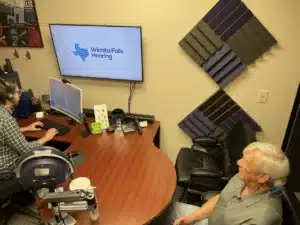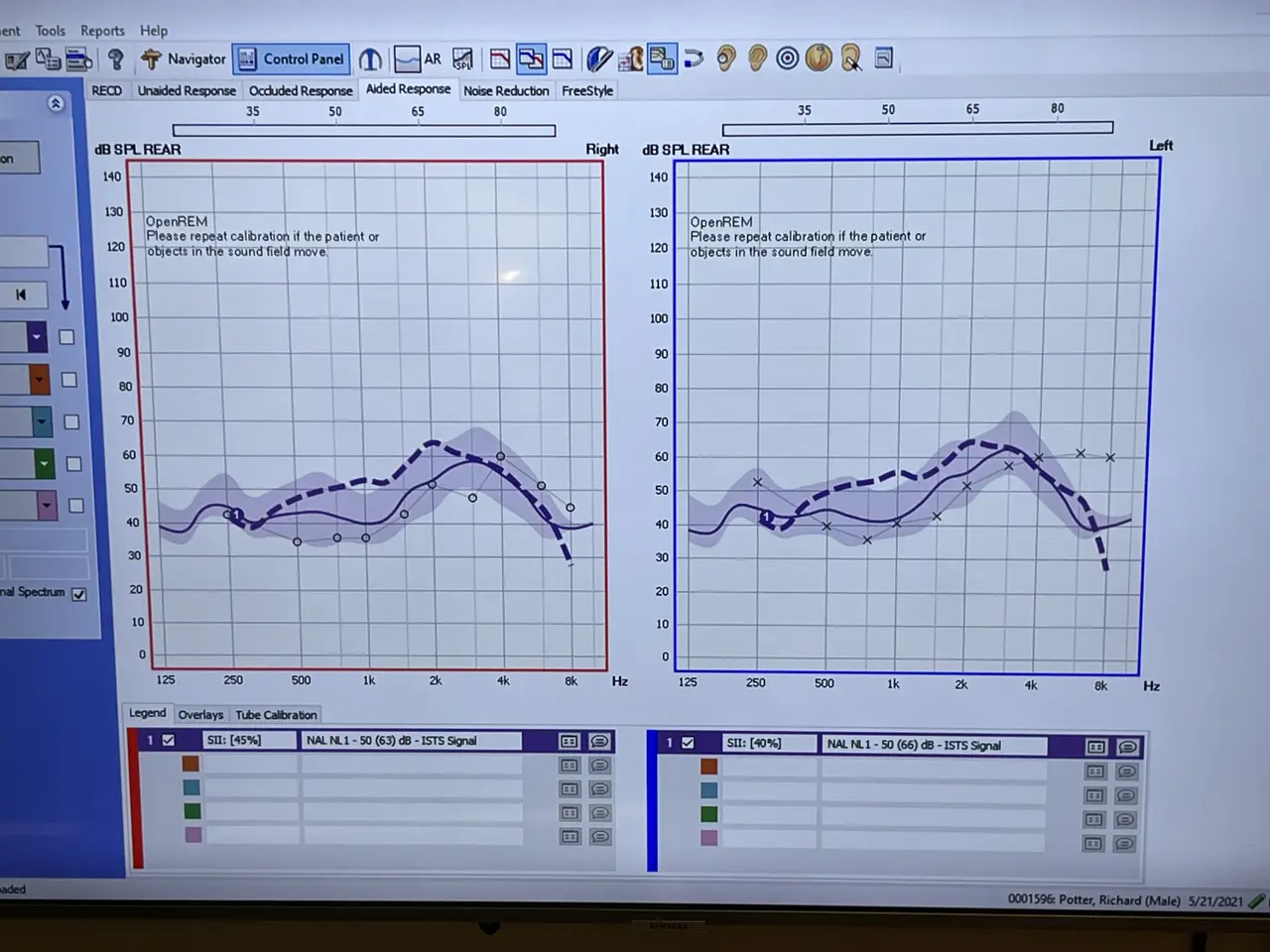Understanding Hearing Aid Programming: A Brief Overview
Hearing aid programming isn’t just fancy tech talk; it’s the heart of making sure your hearing aid does exactly what you need it to do. Think of it like setting up your new phone – you wouldn’t just use it straight out of the box without making it yours, right? Same deal with hearing aids. When you first get a hearing aid, it’s set to a generic mode that kinda helps, but not perfectly. This is where programming jumps in. Your audiologist takes your unique hearing loss profile, which is as personal to you as your fingerprint, and tweaks the hearing aid settings to match. They’ll adjust things like volume, frequencies, and how much noise to block out. It’s not one-size-fits-all; it’s tailor-made to ensure you’re hearing what you’re supposed to be hearing. And, just like updates to your phone, your hearing might change over time, so adjustments may be needed to keep everything sounding right. In short, proper programming makes sure your hearing aid is pulling its weight, giving you the best chance to hear the world around you the way you’re meant to.
The Role of Customization in Hearing Aid Effectiveness
Customization is key to squeezing every drop of benefit from your hearing aid. Think of it this way: everyone’s hearing loss is like a unique fingerprint; no two are exactly the same. That’s why off-the-shelf solutions often miss the mark. When your hearing aid is tailored specifically to your ear’s shape and your hearing loss pattern, that’s when you’ll notice a significant improvement in hearing quality. It’s not just about making sounds louder; it’s about making the right sounds louder, while keeping everything else at a comfortable level. This precise adjustment requires a deep dive into your hearing needs by a professional, often involving several tests to pinpoint the exact frequencies you struggle with. Once this map of your hearing is drawn out, the hearing aid can be programmed to amplify sounds according to your personal needs, leading to a more natural and effective listening experience. Without customization, a hearing aid can feel like a blunt tool; with it, it becomes a finely-tuned instrument that can significantly enhance your day-to-day life.
How Hearing Loss Types Influence Hearing Aid Programming Needs
Hearing loss isn’t one-size-fits-all, and neither should be the programming of your hearing aids. The type of hearing loss you have plays a crucial role in how a specialist tunes your device. Mainly, there are three types of hearing loss: sensorineural, conductive, and mixed. If you have sensorineural hearing loss, the most common type, it means your inner ear or nerve pathways to the brain are damaged. This type often requires detailed programming to amplify sounds without making noise overwhelming. Conductive hearing loss, on the other hand, is due to problems with the ear canal, eardrum, or middle ear and its bones. For individuals with this type, the focus is on making sounds more clear rather than just louder. Mixed hearing loss combines both sensorineural and conductive issues, making the programming a careful balance between clarity and volume. Understanding your hearing loss type ensures your hearing aid is tailored perfectly for your ears, making all the difference in bringing the world into clearer sound.
The Process of Custom Hearing Aid Programming
To get the most out of a hearing aid, custom programming is key. This process starts with your hearing professional running tests to understand your specific hearing loss. It’s not a one-size-fits-all deal. They check how well you hear at different pitches and volumes. Next, they take this data and tweak the hearing aid settings to match your needs. This might happen right in their office using specialized software. You’ll even get to test different environments out, like a crowded room or a quiet space, to see how well the aid performs. Think of it as tailoring a suit to fit you perfectly. Over time, your hearing might change, or the aid might need a tweak. That’s expected. Regular check-ups keep your hearing aid working its best, just for you. It’s a continuous process but one that ensures your hearing aid is always at the top of its game, making sure you’re not missing out on the sounds of life.
The Impact of Personalized Programs on Hearing Aid Performance
When you get a hearing aid, you don’t just want it to work. You want it to work for you. That’s where custom programming comes in. It makes a huge difference in how well your hearing aid performs. See, everyone’s hearing loss is unique, like fingerprints. So, a one-size-fits-all setting? Not going to cut it. Personalized programs are tailored to match your specific hearing needs. This means sounds are clearer, and you can understand conversations better, even in noisy places. It’s like tuning a musical instrument perfectly for a concert. Without this customization, you might miss out on the full benefit of having a hearing aid. In short, custom programming turns a good hearing aid into a great one, making sure it’s hitting all the right notes for your ears.
Professional vs. DIY: The Risks of Generic Hearing Aid Settings
Choosing the right hearing aid is like picking the perfect pair of glasses. Just as glasses are tailored to your vision needs, hearing aids should be customized to suit your hearing loss pattern. When you go for a professional setup, an audiologist adjusts the hearing aid settings based on precise measurements of your hearing loss. This ensures that the device optimally amplifies sounds for your unique needs. On the flip side, going the DIY route with generic settings might seem cheaper and quicker, but it’s like wearing someone else’s glasses. Sure, you might see better than without them, but you won’t be seeing as clearly as you could. With hearing aids, using a one-size-fits-all setting can result in inadequate amplification, discomfort, and even further hearing damage. In short, the risks of sticking with generic settings far outweigh the convenience. Always opt for professional customization to get the best out of your hearing aids.
Key Benefits of Opting for Custom Hearing Aid Programming
Custom hearing aid programming tailors the device to your specific hearing loss pattern, leading to several key benefits. First, it boosts speech clarity. Unlike one-size-fits-all solutions, custom programming matches the device’s output to your unique hearing needs, making conversations clearer and more understandable. Then, there’s the comfort factor. With settings dialed in to match your preferences, these aids reduce the likelihood of experiencing discomfort or auditory fatigue. Another major advantage is the improved listening experience in various environments. Whether you’re in a noisy restaurant or a quiet room, custom programming ensures your hearing aids automatically adjust, providing optimal performance wherever you are. Lastly, it’s about getting the most out of your investment. By precisely fitting the aid to your hearing curve, you minimize the need for future adjustments, making your hearing aids more effective over the long term. In short, opting for custom hearing aid programming translates to clearer sounds, greater comfort, and a highly personalized listening experience.
Real-Life Success Stories: The Difference Custom Programming Makes
Many people underestimate the power of custom hearing aid programming, but the real-life success stories speak volumes. Take Maria, a teacher who struggled in noisy classrooms. After her audiologist customized her hearing aid settings, she reported being able to focus on individual student queries amidst the clamor. Or consider Jack, a music enthusiast who felt disconnected from his passion. Custom programming re-tuned his hearing aids to enhance music clarity, reigniting his love for melodies. These stories highlight that one-size-fits-all doesn’t apply to hearing aids. Personalization can dramatically improve user experience and quality of life.
How to Find a Professional for Custom Hearing Aid Programming
Finding a pro to dial in your hearing aid is key to getting the most out of it. Here’s how to spot the right expert. First, check out professionals with solid credentials. This means looking for names with titles like audiologist or hearing instrument specialist beside them. Next, peer at reviews and ask around. Word of mouth from folks who’ve been in your shoes is gold. Also, see if the professional is keen on using the latest tech. Custom programming ain’t about guesswork; it’s about precision, and that comes with using up-to-date equipment. Lastly, the vibe matters. You want someone who listens to you, understands your lifestyle, and is ready to make adjustments until it’s just right. Remember, it’s not just about hearing, it’s about hearing your way.
Maintaining Your Hearing Aid: Tips and Updates for Optimal Performance
Keeping your hearing aids in top shape makes sure they work well and last longer. Think of them as tiny high-tech devices that need a bit of TLC. First, keep them dry and clean. Moisture and wax can mess with their performance. Use a soft, dry cloth to gently clean them every day. Next, change the batteries regularly or ensure they’re charged. Weak batteries can make your hearing aids less effective. Also, avoid exposing your hearing aids to extreme temperatures. Too hot or too cold, both aren’t good.
Lastly, schedule check-ups with your hearing specialist. These pros can spot issues you might miss and adjust your hearing aid settings if your needs change. By following these steps, you’ll keep your hearing aids working perfectly, ensuring you get the most out of them. For expert guidance in Wichita Falls, schedule an appointment with us!


